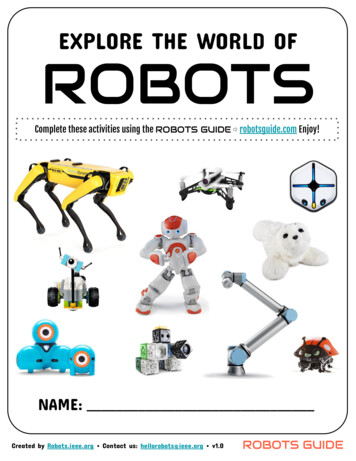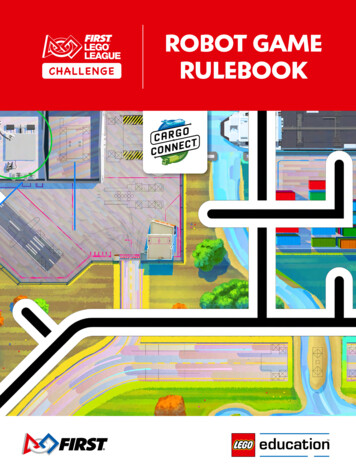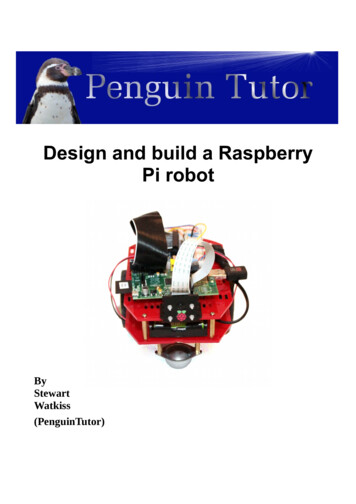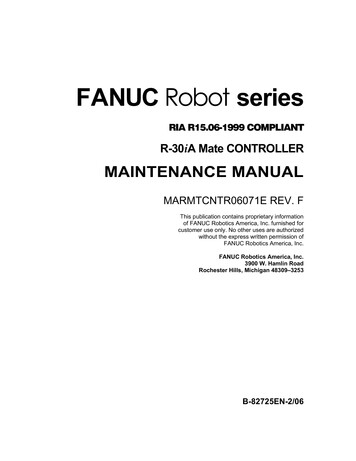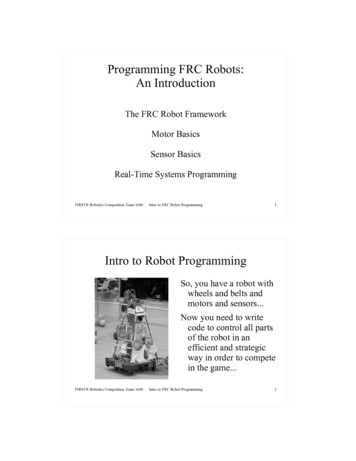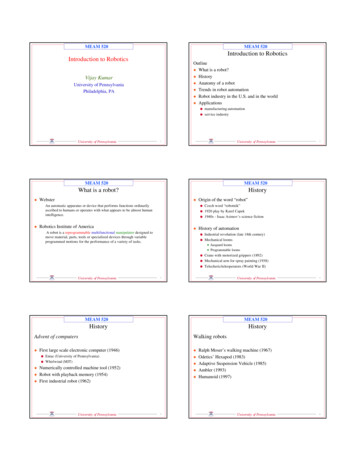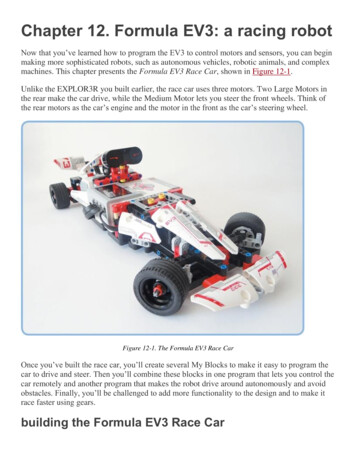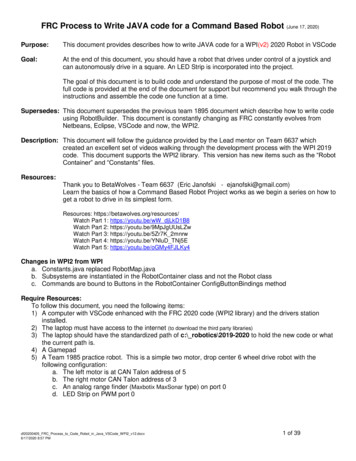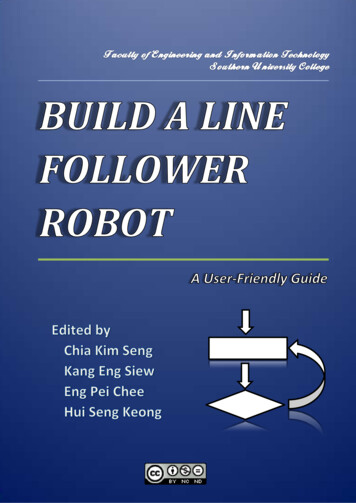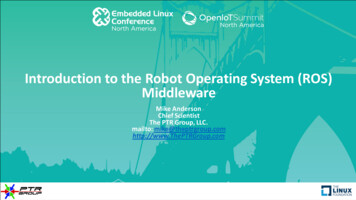
Transcription
Introduction to the Robot Operating System (ROS)MiddlewareMike AndersonChief ScientistThe PTR Group, LLC.mailto: mike@theptrgroup.comhttp://www.ThePTRGroup.com
What We Will Talk About What is ROS?Installing ROSTesting your installationROS componentsROS conceptsComputation graph and naming conventionsYour first robotPub/Sub exampleSummary
What is ROS? The Robot Operating System is a collaborative effort tocreate a robust, general purpose mechanism for creatingapplications for robotics Why? Because robotics control software is hard! Things that seem trivial to a human can be wildly hard for arobot Just think about turning a door knob to open a door orwalking up steps There are so many different robotic applications, no one individual, company,university or laboratory could possibly enumerate all of the options ROS is the culmination of the underlying infrastructure for robotic control, a robust set of tools, acollection of capabilities than can be mixed and matched and a broad community ecosystem ofdevelopers working on specific topic areas
History and Legacy Started in 2007 as an outgrowth of the STanford AI Robot (STAIR) andPersonal Robots (PR) programs from Stanford University in Stanford, CA Sponsored by an local robotics incubator named Willow Garage Willow Garage produced a robot known as the PR2 The purchasers of the PR2 became a loose federation of developerseach contributing their code back to the greater community Licensed under the permissive BSD open-source license However, some modules have licenses like ASLv2, GPLv2, MIT, etc. Latest release is “Lunar Loggerhead” in May of 2017 ROS is supported by the Open Source Robotics Foundation https://www.osrfoundation.org/Source: w illow garage.com
Installing ROS Native ROS installation of either Kinetic Kame or LunarLoggerhead is supported out of the box for Debian-baseddistributions such as Ubuntu, Linux Mint, Debian andderivative distributions Some experimental support for Gentoo, macOS and YoctoSource: ros.org Pretty much your typical add GPG key, add apt sources, apt-get update, apt-getinstall sequence found with Debian PPAs etc. http://wiki.ros.org/lunar/Installation/Ubuntu
Next Steps After the initial installation, you will need to initialize rosdep and set yourenvironment variables sudo rosdep init rosdep update Then take care of the environment: echo "source /opt/ros/lunar/setup.bash" /.bashrc source /.bashrc In order to be able to build ROS packages, you’ll need some additional dependences: sudo apt-get install python-rosinstallpython-rosinstall-generator python-wstool build-essential Now, you’re ready to test the installation
Testing the Installation with a simple build The ROS build system is called catkin The name catkin comes from the tail-shaped flower cluster found on willow trees -- areference to Willow Garage where catkin was created At this point, you’re ready to try a simple build: mkdir –p /catkin ws/src cd /catkin ws/src catkin init workspace Even though the workspace is empty, you can still issue a make cd /catkin ws catkin make
Core ROS Components At its core, ROS is an anonymous publish/subscribe message-passing middleware Communications are asynchronous Some modules will publish a set of topics while others subscribe to that topic When new data is published, the subscribers can learn about the updates and can act on them Communication is implemented using a message-passing approach that forcesdevelopers to focus on clean interface logic Described in the message interface definition language (IDL) ROS supports the recording and playback of messages Messages can be recorded to a file and then played back to republish the data at any time Allows for repeatability and facilitates regression testing
Core ROS Components #2 Support for remote procedure calls via services While asynchronous communications via pub/sub is great, sometimes you need lock-stepsynchronous behaviors Distributed parameter system Tasks can share configuration information via a global key-value store Provides a centralized point for changing configuration settings and the ability to change settings indistributed modules Robot-specific features like a geometry library, mapping and navigationfunctions, diagnostics and much more Extensive diagnostics capabilities
ROS Concepts ROS has three levels of concepts Filesystem level Computation level Community level The filesystem level encompasses resources you’ll likely encounter on disk PackagesMetapackagesPackage manifestsRepositoriesMessage (msg) typesService (srv) types
ROS Concepts #2 The Computation Graph is the peer-to-peer network of ROS processes that are workingtogether ROS computation graph level concepts include: NodesMasterParameter serverMessagesTopicsServicesBags (places to store collected data) The ROS community-level concepts facilitate the exchange of software and knowledgebetween members of the community DistributionsRepositoriesThe ROS WikiBug ticket systemMailing listsROS Answers (FAQ site)Blog (information on updates including videos and photos)
Filesystem Specifics Packages are the primary unit of software in ROS (finest granularity) Contains ROS runtime processes known as nodes, libraries, data sets, configuration files andanything else that’s needed at this level Metapackages are a means to collect packages into related groups The package manifest (package.xml) provides the package name, version, descriptionlicense, dependencies and other metadata related to the package Repositories are collections of packages that share a common version control system Can be released as a unit using the bloom tool and may be mapped into rosbuild Stacks Message types describe the message data structures to be sent Service types define the request/response data structures for the service-level entityin ROS
Computation Graph Level Nodes are the processes that performcomputation Very fine granularity such as motor control, lidarinterface, graphical view, etc. The Master is the clearing house for name registrationand lookup to the rest of the graph Parameter server allows data to be stored, by key, in a central location and is typicallypart of the master Messages are the primary unit of communication in ROS and are data structures madeup of primitive types (integers, floating point, booleans, etc.) and can be nestedSource: ros.org
Computation Graph Level #2 Topics represent the messages that are routed via the pub/sub semantics Node subscribe to topics while others publish topics Supports one-many, many-to-many transport Services are the implementation of the RPC mechanism for synchronouscommunications in ROS Finally, bags are a format for record/playback of ROS message data and are theprimary mechanism for storing sensor data
Naming Structure The communications graph and its components are represented in a global namespace thatlooks like a directory structure / is the top level Resources are defined in their namespace and may define and share other resources Resources can access anything in their namespace as well as those above their namespace Resources in different namespaces can be connected or integrated with code above bothname spaces Typically code stays in its own namespace to preclude accidentally accessing objects of thesame name in a different namespace Each name is resolved locally as though each domain was a top-level domain Names can begin with , / or an alpha character (upper or lower) Subsequent characters are alphanumeric, or /
Name Resolution There are four types of resource names in ROS Base, relative name, global name and private names Base name:Relative name:Global name:Private name:baserelative/name/global/name private/nameNames with no namespace qualifierName relative to the local namespaceFully qualified namesNames that are not visible outside the namespace By default, all name resolution is relative to the local namespace Package resource names take the form of packagename / msgtype E.g., std msgs/String would be the String message type in the std msgs package
Describing Robots in URDF The Unified Robot Description Format (URDF) is an XML-based way forrepresenting a robot model The ROS URDF package contains XML specifications All connections, mechanisms, subsystems, etc. must be described in URDF Can get really tedious They have developed Xacro (XML Macros) as an XML-based macro language tosimplify the definition of large robotic systems Xarco helps reduce duplication of information in the file
Example: Building a Basic Chassis Two basic URDF components are used to define a simple robot chassis The link component describes a rigid body based on its physical properties Dimensions, position in space, color, etc. Links are connected by joint components that describe the characteristics of theconnection E.g., Links connected, types of joint, degrees of freedom, axis of rotation, amount offriction, etc. The URDF description is a set of these link elements and their associated jointelements that connect the links together
A Simple Box in URDF ?xml version '1.0'? robotname “elc robot" !-- Base Link -- link name "base link" visual origin xyz "0 0 0" rpy "0 0 0" / geometry box size "0.5 0.5 0.25"/ /geometry /visual /link /robot A box that is .5m long, .5m wide and .25m tallCentered at the origin of (0,0,0)No rotation in the roll, pitch, or yaw (rpy)
Create the Package We need to create a package for this URDF to be placed catkin create pkg elc robotCreated file elc robot/package.xmlCreated file elc robot/CMakeLists.txtSuccessfully created files in/home/mike/catkin ws/src/elc robot. Please adjust the valuesin package.xml. cd /catkin ws catkin make lots of build output
Create the urdf Directory and Populate it In the elc robot directory, we create a urdf directory for the model XML cd src/elc robot mkdir urdf Copy the URDF model into the urdf directory In order to run the model, we need a launch specification (also in XML) that can bepassed to the roslaunch command We’ll be using a simple visualizer called rviz to get started Create a launch directory and then create a elcrobot rviz.launch as shown onthe next page mkdir launch vi elcrobot rviz.launch; use your favorite editor
Create the Launch File Here is an example of a launch file: launch !-- values passed by command line input -- arg name "model" / arg name "gui" default "False" / !-- set these parameters on Parameter Server -- param name "robot description" textfile " (find elc robot)/urdf/ (arg model)" / param name "use gui" value " (arg gui)"/ !-- Start 3 nodes: joint state publisher, robot state publisher and rviz -- node name "joint state publisher" pkg "joint state publisher" type "joint state publisher" / node name "robot state publisher" pkg "robot state publisher" type "state publisher" / node name "rviz" pkg "rviz" type "rviz" args "-d (find elc robot)/urdf.rviz" required "true" / !-- (required "true") if rviz dies, entire roslaunch will be killed -- /launch
Launch the Model in all its Glory! cd /catkin ws/src/elc robot/ roslaunch elc robot \elcrobot rviz.launch \model: elc robot.urdf Wow, that’s a lot of work for a box! But, it gets better! Let’s put some wheels on it and color itsomething other than red We’ll need to describe the wheels, theirradius, the joint connection to the base link,their inertia, collision characteristics and mass
Box with Wheels! After making all of the necessarymodifications, we have: Clearly, there is a lot of set up todefine the robot and all of itsconnections But, once that’s done, we can actuallydrive it around using gazebo
Gazebo ROS is compatible with a 3-D world simulatorknown as gazebo With gazebo, you can take the model you’vebuilt and place it into a simulated world so youcan drive it around, manipulate gravity, etc. Gazebo is a separate install unless you installthe “full desktop” version of ROS initially
Example Pub/Sub The ROS wiki has a simple Pub/Sub example tutorial at: Subscriber%28c%2B%2B%29 Walking through the code can be most enlightening because you get to see thedefinition of a message and the process for publishing/subscribing Clearly, there’s a lot more to all of this But, at least it’s a start
Summary This has been a whirlwind tour of a clearly complex piece of code We’ve merely scratched the surface on this Defining the geometries of the robot can be daunting It’s a lot easier to build it in the real world! But, having described all of the interfaces and the message types andinteractions you will have a much better understanding of your robot Fortunately, there is a large community around ROS So, lots of folks to answer your questions And, many good reference books
Questions?
The Robot Operating System is a collaborative effort to create a robust, general purpose mechanism for creating applications for robotics Why? Because robotics control software is hard! Things that seem trivial to a human can be wildly hard for a robot Just think abou

